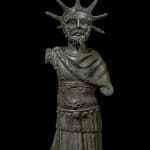Roman
Further images
Provenance
Collection of Léon Rodrigues-Ely (1924-1973), Marseille, France, acquired before 1970, thence by descentRodrigues-Ely, a passionate collector of ancient art, was the heir of a French family which dominated the shipping business from Bordeaux and Marseille to America in the 18th and 19th centuries.
Literature
This masterful bronze figure depicts the emperor Marcus Aurelius Antoninus (r. AD 161-180) as a victorious military commander. The emperor is shown in his fourth official, and last portrait type, wearing a radiate crown.
Marcus Aurelius Antoninus was the last of the 'five good emperors' of the Nerva-Antonine dynasty and his death marked the end of the Pax Romana, a ‘golden age’ of relative stability, prosperity, and power in the Roman Empire.
The archetypal philosopher-emperor, Marcus Aurelius was a devoted follower of the Greek philosophy of Stoicism, and is perhaps best known for his celebrated work Meditations. This philosophical treatise written in Greek reflects on death, war, and fame. His writing indicates that he studied the burden of power and wanted to live his life in harmony with nature.
From the middle of the 2nd century AD onwards, the radiate crown, an attribute of Sol Invictus / Helios, was used to symbolise and promote the idea that the emperor was protected by and a personification of the sun god. From Alexander onwards, rulers and emperors were often linked with traditional gods, assimilating and integrating with the pre-existing iconographic and mythological language of divine power and rule. This syncretising of the emperor with Helios/Sol helped to underline his invincibility, particularly in the military realm. Similar portraits of the Marcus Aurelius wearing the radiate crown can be seen on his coinage, in particular on his dupondi.
Sol Invictus was a deity that became closely linked with the Roman army. There are a number of extant dedications associated with Roman soldiers and army camps. That Marcus Aurelius would be shown invoking Sol Invictus is unsurprising given that his reign was marked by years of warfare, and he spent most of his time in military camps with his army.
His success and identity as a military leader is represented here through the garments he is wearing. Cuirassed or military garbed statues of rulers began to make their appearance in the Hellenistic period, following the iconographic language of conveying military might and ruling authority established by Alexander the Great. It is unsurprising that the period from which most imperial cuirassed statues date is the 2nd century AD. Given that the empire stretched from the Atlantic to Mesopotamia, Britannia to Africa, and relied on its army to maintain the Pax Romana, the populating of cities across the empire with large scale public statuary of the emperor in military guise was a calculated and visual statement of the Imperial cult and the emperor as ruler and god through the might of his army.
It is thought that this practice of cuirass sculpture developed from the traditional Roman trophies, which consisted of a Roman cuirass hung on a pole or tree stump as a ritual monument of victory. These trophies in the 2nd century AD were made in the guise of the emperor so that he himself became a living trophy glorifying his prowess and excellence.
In light of the emperor's prolific military exploits this large-scale bronze figure can be viewed in the context of a mobile cult of the emperor, which aimed at asserting his presence both in the provinces and amongst the Roman troops who were stationed throughout the empire. For a similar example of a cuirass statuette also thought to be Marcus Aurelius see, D.G. Mitten and S.F. Doeringer, Master Bronzes from the Classical World, 1967, no. 278, p.284.







